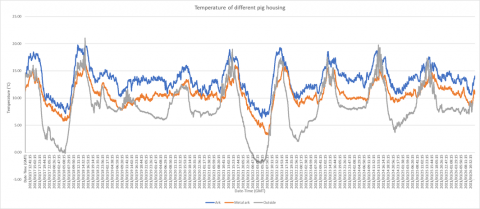Comparing pig arks to improve welfare at Forest Coalpit Farm
As cold and heat stress can cause health problems, reduced growth rates and poor reproductive performance, it is fundamental that pigs stay within their thermal neutral zone as much as possible to keep them growing quickly, and to keep feed bills to a minimum.
A trial is currently taking place at Forest Coalpit Farm to compare the efficiency of the new ‘Aardvark’ farrowing arks that Kyle Holford and Lauren Smith have recently purchased. The new plastic arks are UV stable and should prove to be a number of degrees cooler in summer and warmer in the winter compared to traditional pig ark structures.
As part of the trial, three temperature loggers are being used to compare two different types of arks. The first logger has been fixed to the inside of the ‘Aardvark’s’ roof, the second to the side paneling of the old, more traditional steel ark/shed, and the third has been installed onto a fencing stake that’s located close to both arks (to record external temperature).
The results in Fig.1 show that the temperature inside the ‘Aardvark’ tends to be warmer during colder periods compared to the steel ark. During the coldest period, when the external temperature falls to -2°C, the steel ark falls to 3°C, but the temperature inside the plastic ark doesn’t fall below 6°C.
Kyle Holford believes that changing from the old, more traditional arks to the new ‘Aardvarks’ has also reduced piglet mortality and straw usage due to its round, more spacious shape.
The next step of the trial is to compare both arks during warmer temperatures.
Figure 1. Temperature sensors (Grey- Outside temperature, Blue- Aardvark temperature, Orange- traditional steel ark)

